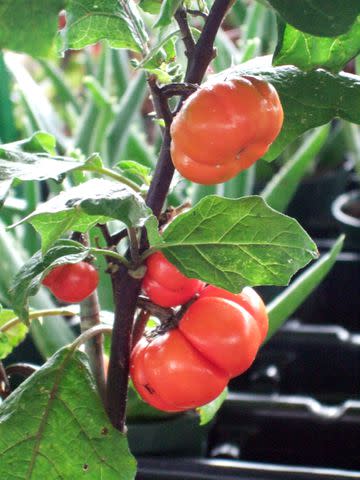How to Plant and Grow Pumpkin on a Stick
Pumpkin on a stick is actually an edible type of eggplant that also makes a fun fall decoration.

Denny Schrock
While the fruit of these fantastical plants might look like small pumpkins growing along an upright stem, they are in fact a type of eggplant. Believed to hail from Africa, they have been grown for hundreds of years (if not longer) for their edible fruits, leaves, and stems. Aside from being edible, the brightly colored fruits make excellent fall decorations.

Denny Schrock
Growing your own tiny pumpkin-like fruits at home requires a little more care than their relatives, tomatoes, but is still easy enough to do. Follow this guide to growing your own pumpkin on a stick plant, complete with helpful tips on where to plant, how to feed and water, and how to eventually harvest your crop.
Where to Plant
Plant pumpkin on a stick in a garden location with full sun and give it plenty of space for air circulation. In general, these plants do not get especially large (about 3 feet tall by 2 feet wide), but they may benefit from the use of tomato cages. In cooler climates, plant on the south side of a building, fence, or other structure to help preserve additional solar heat.
Related:The 12 Best Tomato Cages of 2023
How and When to Plant
Pumpkin on a stick is cold sensitive and should be planted outdoors after the danger of frost has passed in spring. Like tomatoes, these plants also benefit from fertile, loamy soils with good drainage and plenty of moisture.
Plant Care Tips
Light
Like most fruit crops, pumpkin on a stick requires full sun (8+ hours) for best growth and fruit production. If plants are started indoors before planting in the garden, artificial lighting can be beneficial and will help avoid etiolation (lengthening of the stem in search for light) which can lead to thin, weak plants.
Related:The 12 Best Grow Lights to Help Your Plants Thrive in 2023
Soil and Water
Sow your plants in rich, loamy soil with excellent drainage but good water retention. Pumpkin on a stick needs consistent moisture to produce large, fully-formed fruits.
Temperature and Humidity
Just like its relatives, tomatoes, pumpkin on a stick thrives in the heat of summer and grows quickly in the right conditions. While native to the tropics, these plants do not require high humidity and might actually succumb to fungal and bacterial infections in especially humid locations without adequate airflow.
Fertilizer
While these plants will thrive when fed, avoid using a fertilizer with large amounts of nitrogen (N). Excess nitrogen will result in overly leafy plants and fewer fruits. Like tomatoes, pumpkin on a stick may also benefit from a fertilizer mix containing calcium to avoid blossom end rot. Tomato fertilizers typically make a good choice for use.
Pruning
Pruning is not usually necessary for pumpkin on a stick. However, broken branches, excess side shoots, and otherwise undesirable growth can be pruned off at any time.
Pests and Problems
While generally unaffected by major diseases, pumpkin on a stick can succumb to a variety of pests. Typical pests might include aphids, whiteflies, mealybugs, tomato hornworms, and scale. Because of their edibility and use as decorations, always use an organic pesticide. A general purpose insecticidal soap or pyrethrin can control most insect pests while BT can be effective against hornworms.
In areas with high humidity, fungal infections can take hold. Use a copper-based fungicide and/or neem oil to thoroughly drench plants in the evening or early morning. Remove any leaves or other organic matter from around the base of the plants as well to avoid reinfection by spores.
How to Propagate Pumpkin on a Stick
Pumpkin on a stick is best to propagate from seeds. Start seeds indoors in containers about 6-8 weeks before your last frost free date to get a head start on the growing season. Seeds take about 5-10 days to sprout. After they have produced their third or fourth set of leaves, carefully transplant seedlings into the garden after hardening them off. Due to their eventual large size, pumpkin on a stick should be planted in the ground, but it can be grown successfully in containers as well.
Companion Plants for Pumpkin on a Stick
Whether grown in pots or in the garden, pumpkin on a stick can benefit from companion planting with French marigolds to help to deter nematodes and roundworms from attacking the plants’ roots.
Harvesting Pumpkin on a Stick
Pumpkins on a stick are easy to harvest for decoration once the fruits have fully matured to their bright orange color. Simply use a pair of pruners/shearers to cut the stem well below the fruit and hang in a cool, dry location. Eventually the green stem will dry and the fruits will remain orange. Alternatively, individual fruits can be cut from the main stem.
Related:The 12 Best Pruning Shears of 2023 to Keep Your Garden in Check
Frequently Asked Questions
Are pumpkin on a stick poisonous?
Yes, as a member of the genus Solanum, pumpkin on a stick is toxic to some species and should be kept away from dogs, cats, and horses.
Is pumpkin on a stick safe to eat?
Humans have been serving up pumpkin on a stick and other types of eggplant for hundreds of years. The shoots, leaves, and fruits of pumpkin on a stick are all edible.
Can pumpkin on a stick be grown indoors?
Pumpkin on a stick grows best with plenty of sunlight and room to spread their roots in the soil, which can be challenging conditions to meet indoors. To grow as a houseplant, pumpkin on a stick needs a large pot and artificial grow lights for proper fruit production.
For more Better Homes & Gardens news, make sure to sign up for our newsletter!
Read the original article on Better Homes & Gardens.

